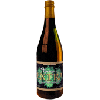Brasserie Thiriez - Extra
-
ABV:
4.50% -
Serving Temperature:
45-50° F -
Suggested Glassware:
Tulip or Oversized Wine Glass
Extra is an interesting joint effort with English brewer John Davidson, founder of Swale Brewery, who now lives in France as the proprietor of the microbrewery Bièrs23 in Creuse. The French and the English, willfully working together? Behold the unifying power of craft beer. In the UK and in France, this beer is called “Les Frères de la Bière,” meaning “Brothers of the Beer,” reflecting the collaboration effort. It uses one hop varietal, a rather unusual hop grown in Kent, UK, called 'Bramling Cross.' The malt is from 2-row spring barley grown in France. The result has certain characteristics of an English bitter: not too strong, very dry, and eminently drinkable. In other words, a daftly flavorful beer at a low alcohol by volume. With the tremendous hops dosing, however, you might expect this to approach English IPA. But French brewer Daniel Thiriez is 'Belgian-oriented' by his own admission, and uses a Belgian yeast that he obtained from the Belgian brewing school where he studied. Accordingly, the beer also has a good bit of the earthy, spicy character of a saison. Take care when opening the bottle that you have your glassware at the ready, because immediately after popping the cap, the froth begins to snake out of the bottle mouth. Even with a gentle pour, you can expect that only perhaps 1/10th of what makes it into the glass is not-foam. It will take many minutes to get the beer to settle and to fill a glass, but trust us, it’s worth it! The beastly head is monstrous, frothy, and cloud-like in appearance. The beer is orange-gold in color, and hazy, with intense sticky lace all over the damned place. The bouquet is simply wonderful; expect vibrant notes of citrus with an edgy spiciness. Ample hops give off notes of fresh mint sprig (and this mint presence is quite big). The Belgian yeast strain gives some coriander and saffron-like spice notes. The sturdy malt profile holds up against the hops and provides notes of honeycomb. Finally, look for faint notes of vanilla, oranges and talcum. Look for a profoundly earthy and minerally flavor profile. There are deep layers of spiciness, with mild toasty malt notes emerging through the spice. Highly floral, lilac-esque notes peak through, ushering in a slow-to-build but ample bitterness at the back and sides of the tongue, culminating in a chalk dust-like dryness. A full-flavored, complex, yet low alcohol beer—no small feat, believe us.
Historically, farmhouse ales needed to be sturdy enough to hold up through summer when brewing was impossible, but drinkability was paramount in hot weather. How to bolster the beers stability? Turns out that hops are a great natural preservative. So is alcohol, mind you, but alcohol tends to hurt refreshment, and it seems that many beers in this style, though often at 7+% ABV these days, were once in the 3-4% ABV range, using a hefty dose of hops as a preservative. So, this beer makes the old new again; while overly hoppy by many assessments for the farmhouse ale style, it just may be more like the original examples than what has come to embody the style today.
Historically, farmhouse ales needed to be sturdy enough to hold up through summer when brewing was impossible, but drinkability was paramount in hot weather. How to bolster the beers stability? Turns out that hops are a great natural preservative. So is alcohol, mind you, but alcohol tends to hurt refreshment, and it seems that many beers in this style, though often at 7+% ABV these days, were once in the 3-4% ABV range, using a hefty dose of hops as a preservative. So, this beer makes the old new again; while overly hoppy by many assessments for the farmhouse ale style, it just may be more like the original examples than what has come to embody the style today.
About 150 miles due north of Paris, at the northern tip of France, just about 12 miles south of the famous northern seaport town of Dunkerque (Dunkirk) you'll find Brasserie Thiriez. Daniel Thiriez founded his brewery in 1996 shortly after settling in this region of France, in the small town of Esquelbecq. We understand why he chose to make this area his home, with its lush hillsides in the rolling farm country of French Flanders; it's a beautiful place to live.
The brewery is housed in a rustic, rather small brick-and-beam building that harkens back to the days of true farmhouse brewing that took place here before this area was considered French or Belgian. Daniel holds a brewing degree from a Belgian university and brews his beer in a decidedly Belgian-style, with French farmhouse flair and a regionally atypical heavy hand when it comes to hops. He manages to push the envelope with some of his beers while maintaining a traditional approach to brewing.
His brewery buildings were originally those of the old Poitevin firm-brewery, which brewed on the site until 1945 (quite impressive considering that the town of Dunkerque, just a few miles away, was 80% leveled by Nazi bombings from 1940-1945). After having been home to five breweries (and a few dozen pubs), the village of Esquelbecq did not produce beer for nearly one half-century, until Daniel set up shop in 1996. Local residents were glad he did, as we're sure you'll be too. À Votre Santé!
For more information about the brewery, check out their web site: www.brasseriethiriez.com.

Unmatched Variety by style, brewery & country
Choose from Five different Beer Clubs offering unmatched variety by brewery,
country of origin, and beer style to suit your specific tastes.


